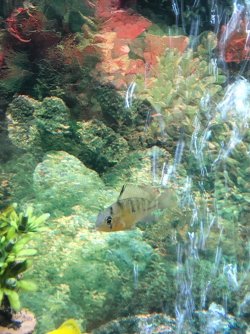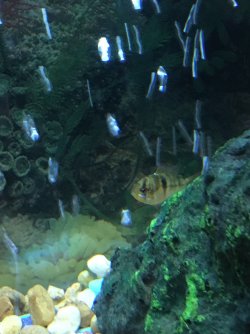The suckermouth catfish has nothing to do with the pH dropping.
Rinse the test phial out several times with the water you are testing, before doing the test. This will rinse out any potential residue from previous tests. Same deal after doing a test, rinse the phials out well under tap water then shake dry or turn upside down on a rack to dry out.
Make sure you use a cap on top of the test phial so the acids on your skin don't contaminate the water being tested, and to keep the test reagent off your skin. The chemicals they use in water testing kits are pretty toxic so it's best to avoid coming in contact with them.
A simple way to slowly raise the pH of the water is to add some limestone or sandstone rocks to the tank. You can also add shells as ornaments, or a bag of shells to a filter. And dead coral skeletons can also be used but most are sharp and limestone, sandstone or shells are a better option.
Limestone, sandstone, coral skeleton and shells are all calcium carbonate and neutralise acids in water and raise the pH. The more you have in the tank, the faster the pH will go up.
If you have African Rift Lake cichlids then get a Rift Lake Water conditioner and add that to some tap water, allow the mineral salts in the Rift Lake conditioner to dissolve and then use that water for water changes.
----------------------
If you have locally bred bristlenose catfish they should be fine in hard water. A lot of people keep and breed bristlenose catfish in Rift Lake tanks with hard water and have been doing so for many years. If you can find local bred, or fish from somewhere that has hard water, you are fine.
If you want "wild caught" bristlenose or other types of suckermouth catfish like Peckoltias, Panaques, etc, they should be kept in soft water.
Rinse the test phial out several times with the water you are testing, before doing the test. This will rinse out any potential residue from previous tests. Same deal after doing a test, rinse the phials out well under tap water then shake dry or turn upside down on a rack to dry out.
Make sure you use a cap on top of the test phial so the acids on your skin don't contaminate the water being tested, and to keep the test reagent off your skin. The chemicals they use in water testing kits are pretty toxic so it's best to avoid coming in contact with them.
A simple way to slowly raise the pH of the water is to add some limestone or sandstone rocks to the tank. You can also add shells as ornaments, or a bag of shells to a filter. And dead coral skeletons can also be used but most are sharp and limestone, sandstone or shells are a better option.
Limestone, sandstone, coral skeleton and shells are all calcium carbonate and neutralise acids in water and raise the pH. The more you have in the tank, the faster the pH will go up.
If you have African Rift Lake cichlids then get a Rift Lake Water conditioner and add that to some tap water, allow the mineral salts in the Rift Lake conditioner to dissolve and then use that water for water changes.
----------------------
If you have locally bred bristlenose catfish they should be fine in hard water. A lot of people keep and breed bristlenose catfish in Rift Lake tanks with hard water and have been doing so for many years. If you can find local bred, or fish from somewhere that has hard water, you are fine.
If you want "wild caught" bristlenose or other types of suckermouth catfish like Peckoltias, Panaques, etc, they should be kept in soft water.



